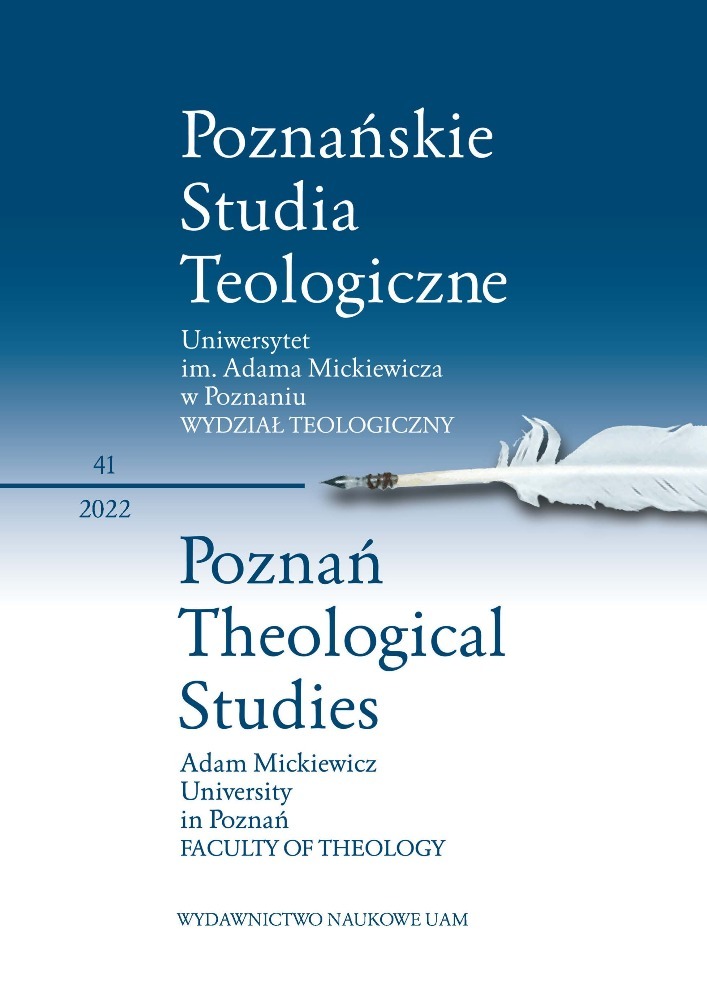Abstrakt
In the presented article I deal with the reception of ancient Jewish rituals by the author of the Old Polish apocryphon Żywot Pana Jezu Krysta. These are two celebrations closely related to the birth of a male descendant: the offering of the newborn and the cleansing of the mother from cultic impurity. The aim of the article is to indicate the manner in which this reception took place, as well as its theological consequences for medieval Mariology.
Bibliografia
Chizkuni, Szemot, חזקוני, שמות י״ב:ט״ו , https://www.sefaria.org/Chizkuni%2C_Exodus.12.15.1?lang=he [dostęp: 13.6.2021].
Pismo Święte Starego i Nowego Testamentu. Najnowszy przekład z języków oryginalnych z komentarzem, Częstochowa: Święty Paweł 2008.
Szulchan Aruch, Yoreh Deˈah, https://www.sefaria.org/Shulchan_Arukh,_Yoreh_De’ah [dostęp: 26.1.2022].
Tagum Neofiti. Księga Wyjścia, tłum. i oprac. M.S. Wróbel, Lublin: Gaudium 2017.
Tora Pardes Lauder. Księga Wyjścia, red. i tłum. S. Pecaric, Kraków: Stowarzyszenie Pardes 2003.
Zywot wszechmocnego syna bożego pana Jezu krysta […]: Wedle ewanielist swietych, zrozmyslanim bożym, nowo są przyłożony […], https://crispa.uw.edu.pl/object/files/318676/display/Default [dostęp: 26.1.2022].
Żywot Pana Jezu Krysta, https://apocrypha.amu.edu.pl/ [dostęp: 26.1.2022].
Ajah M., An Assessment of the Priestly Emolument in Numbers 18:8–32, „Scriptura 103 (2010), s. 107–121. https://doi.org/10.7833/103-0-592 DOI: https://doi.org/10.7833/103-0-592
Baḥya (Beḥai) Ben Asher Ben Halawa, oprac. K. Kaufmann, P. Bloch, https://jewishencyclopedia.com/articles/2367-bahya-behai-ben-asher-ben-halawa [dostęp: 13.6.2021].
Carmichael C., The Book of Numbers. A Critique of Genesis, Yale: Yale University Press 2012.
Cooper J.E., Can the World Be Redeemer? Geʾulah versus Pidyon: Toward a Mundane, Non-Eschatological Approach to Redemption, „Journal of Jewish Thought & Philosophy” 29 (2021), s. 39–54. https://doi.org/10.1163/1477285X-12341316 DOI: https://doi.org/10.1163/1477285X-12341316
Dec P., Zwój Hymnów Dziękczynnych z Qumran (1QHodajota). Rekonstrukcja – przekład – komentarz, Kraków: The Enigma Press 2017.
Erbele-Küster D., Body, Gender, and Purity in Leviticus 12 and 15, New York: T&T Clark 2017.
Esler P.F., Community and Gospel in Luke–Acts. The Social and Political Motivation of Lucian Theology, Cambridge: Cambridge University Press 1987. https://doi.org/10.1017/CBO9780511554933 DOI: https://doi.org/10.1017/CBO9780511554933
Halayqa I.K.H., A Comparative Lexicon of Ugaritic and Canaanite, Münster: Ugarit-Verlag 2008.
Isaacs R.H., Rites of Passages: A Guide to the Jewish Life Cycle, Hoboken: KTAV Publishing House 1992.
Kaufmann Y., The Religion of Israel. From Its Beginnings to the Babylonian Exile, London: George Allen & Unwin LTD 1961.
Klopper F., The Rhetoric of Conflicting Metaphors: A Fountain Desired in the Song of Songs but Abhorred in Leviticus, „Old Testament Essays” 15 (2002) 3, s. 675–686.
Lemański J., Księga Wyjścia. Wstęp, przekład z oryginału, komentarz, NKB ST, t. I, cz. I, Częstochowa: Edycja Świętego Pawła 2013.
Meyers C., Exodus, Cambridge: Cambridge University Press 2005.
Mickiewicz F., Ewangelia wg św. Łukasza. Rozdziały 1–11, NKB NT, t. III, cz. I, Częstochowa: Edycja Świętego Pawła 2011.
Milgrom J., The Commentary to Numbers, Philadelphia: Jewish Publication Society 2003.
Milgrom J., Were the Firstborn Sacrificed to YHWH? To Molek? Popular Practice or Divine Demand?, w: Sacrifice in Religious Experience, ed. A.I. Baumgarten, Leiden: Brill 2002, s. 49–55. https://doi.org/10.1163/9789004379169_005 DOI: https://doi.org/10.1163/9789004379169_005
Moessner D.P., Luke the Historian of Israel’s Legacy, Theologian of Israel’s ‘Christ’, Berlin: De Gruyter 2018.
Oswald W., Die Exodus-Gottesberg-Erzählung als Gründungsurkunde der judäischen Bürgergemeinde, w: Law and Narrative in the Bible and in the Neighbouring Ancient Cultures, ed. K.-P. Adam, F. Avemarie, N. Wazana, Tübingen: Mohr Siebeck 2012, s. 35–51.
Pirngruber R., Toward a Framework for Interpreting Social and Economic Change in Babylonia during the Long 6th Century BCE, w: Xerxes and Babylonia: The Cuneiform Evidence, ed. C. Waerzeggers, M. Seire, Leuven: Peeters 2018, s. 19–33. https://doi.org/10.2307/j.ctv1q26v46.5 DOI: https://doi.org/10.2307/j.ctv1q26v46.5
Schearing L.S., Double Time… Double Trouble? Gender, Sin, and Leviticus 12, w: The Book of Leviticus. Composition and Reception, ed. R. Rendtorff, R.A. Kluger, Leiden: Brill 2002, s. 429–450. https://doi.org/10.1163/9789047401643_023 DOI: https://doi.org/10.1163/9789047401643_023
Słownik staropolski, https://pjs.ijp.pan.pl/sstp.html [dostęp: 26.1.2022].
The Dictionary of Classical Hebrew, t. VI–VII, ed. D.J.A. Clines, Sheffield: Sheffield Phoenix Press 2011.
Thiessen M., Luke 2:22, Leviticus 12, and Parturient Impurity, „Novum Testamentum” 54 (2012), s. 16–29. https://doi.org/10.1163/156853611X589624 DOI: https://doi.org/10.1163/156853611X589624
Licencja
Prawa autorskie (c) 2022 Andrzej Jędrzejczak

Utwór dostępny jest na licencji Creative Commons Uznanie autorstwa – Użycie niekomercyjne – Bez utworów zależnych 4.0 Międzynarodowe.

